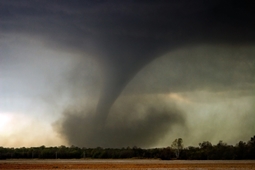Nature's Most Violent Storms
Tornadoes can cause fatalities and devastate neighborhoods in seconds. A tornado’s whirling winds can reach 300 miles per hour and damaged paths can be in excess of a mile wide and 50 miles long. Every state is at some risk from this hazard.
Some tornadoes are clearly visible, while rain or nearby low-hanging clouds obscure others. Occasionally, tornadoes develop so rapidly that little, if any, advance warning is possible. Since there is not a lot of warning when a tornado might strike, it is especially critical to act immediately when alerts are issued.
In your Household
-
Move to the basement as soon as possible and get under sturdy protection such as a table or workbench. Stay away from windows and heavy objects.
-
If you do not have a basement, move to the lowest possible floor of your home. If there is an interior hallway, crouch there with thick padding over your head, such as a mattress or pillow. If there is not a hallway, find a small room, such as a bathroom and crouch in the corner
Mobile Home Residents
-
People living in mobile homes, even those with tiedowns, should seek safe shelter elsewhere at the first sign of severe weather.
-
Go to a pre-arranged shelter or talk to a friend or relative ahead of time to see if you can go to their home when the weather turns bad.
-
Talk to the mobile home park management about the availability of a nearby shelter.
-
As a last resort, go outside and lie flat on the ground with your hand over your head and neck. Be alert for flash floods that often accompany these storms.
If you are Driving
-
Never try to outrun a tornado.
-
If you see a funnel cloud or hear a warning issued on the radio or by siren, get out of your vehicle and seek a safe structure or lie down in a low area with your hands covering the back of your head and neck. Keep alert for flash floods.
School or Office Buildings
-
Learn the emergency shelter plans for office buildings or schools that you frequent. If there is no shelter, move to an interior hallway or small room on the lowest level of the building. Avoid areas with glass and wide, freespan roofs.
-
If you can not get into a basement or designated shelter, move to the center of the lowest level of the building, away from windows, and lie flat on the ground.
Shopping Malls
-
Go to a designated shelter area or to the center of the mall on the lowest level. Stay away from large, open rooms and windows. Never seek shelter in cars in the parking lot or parking garage.




















